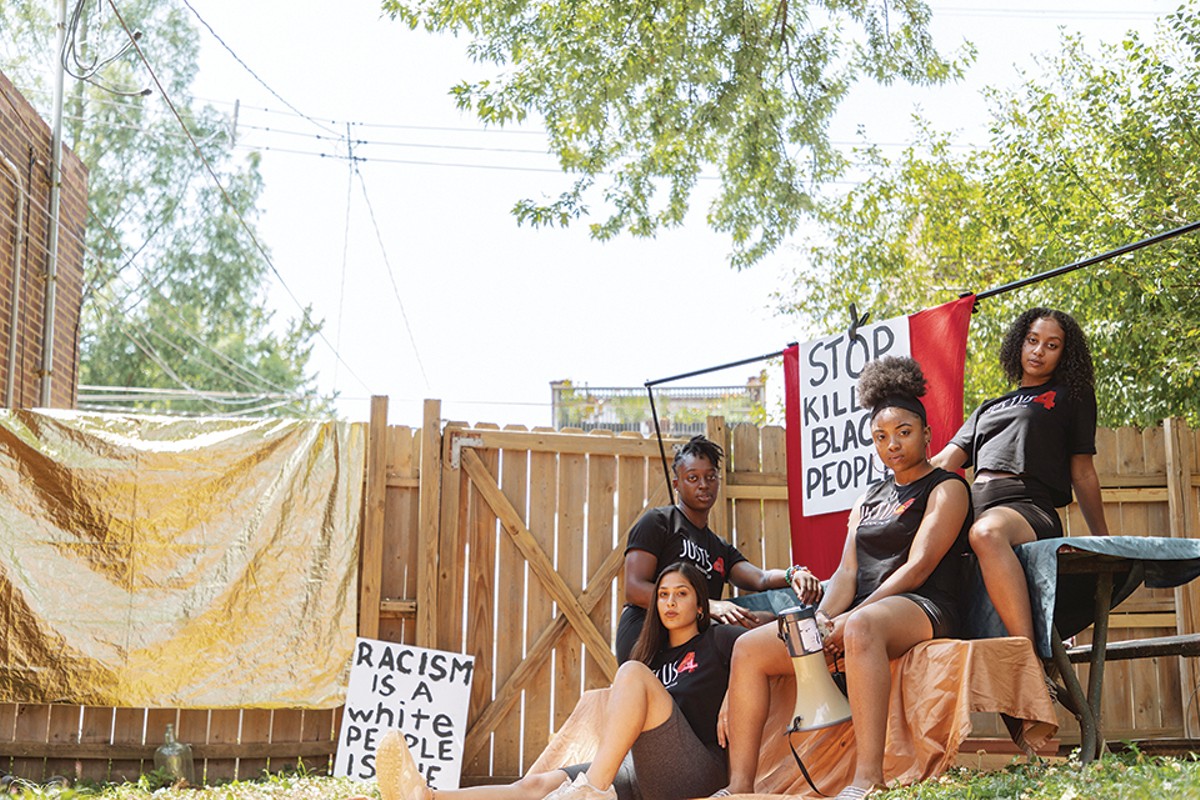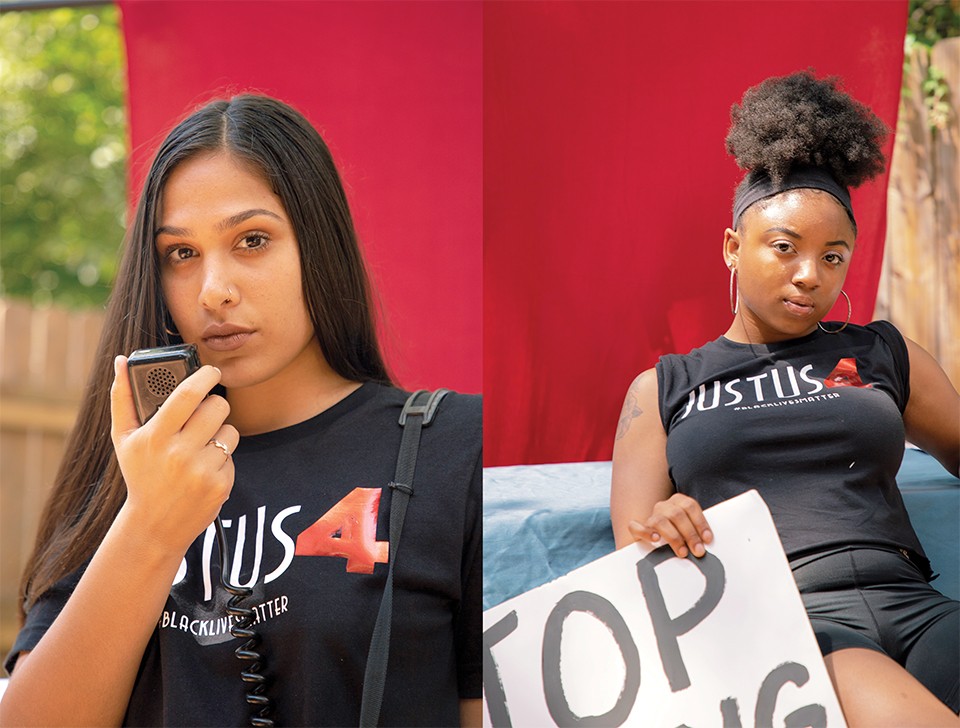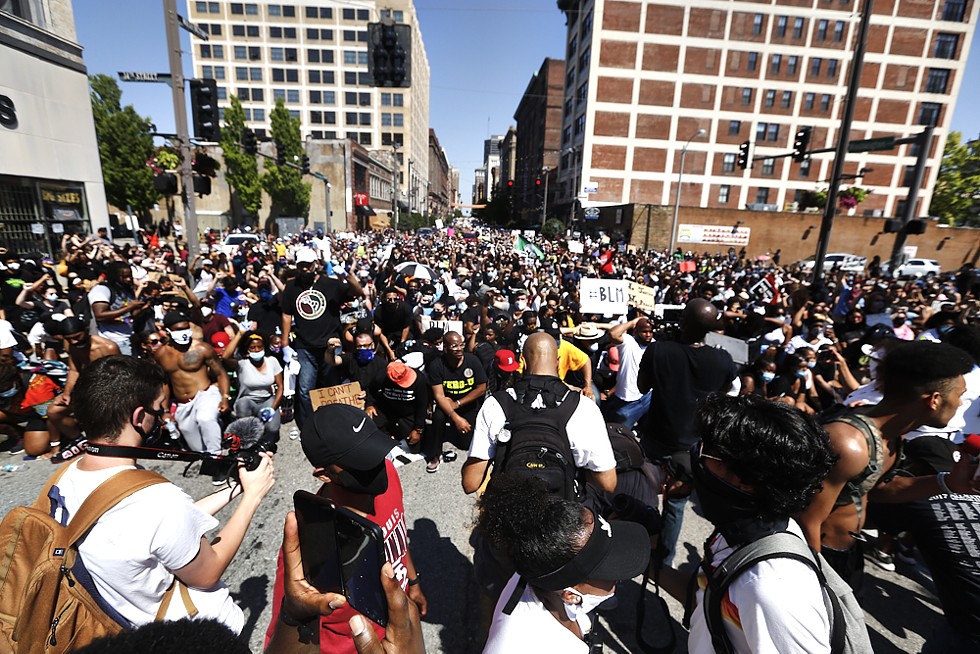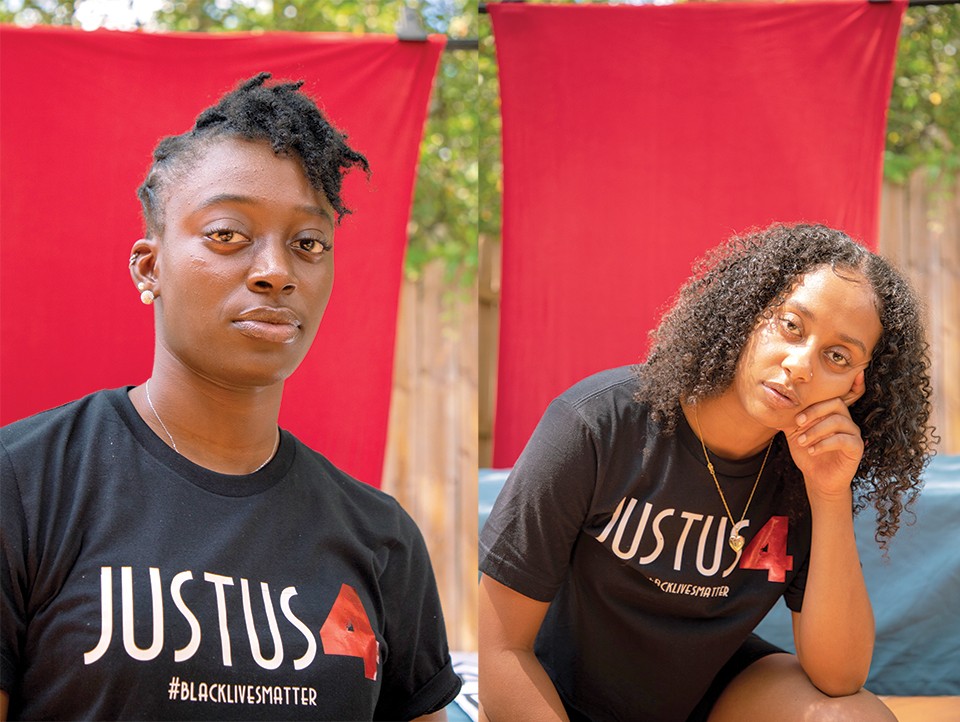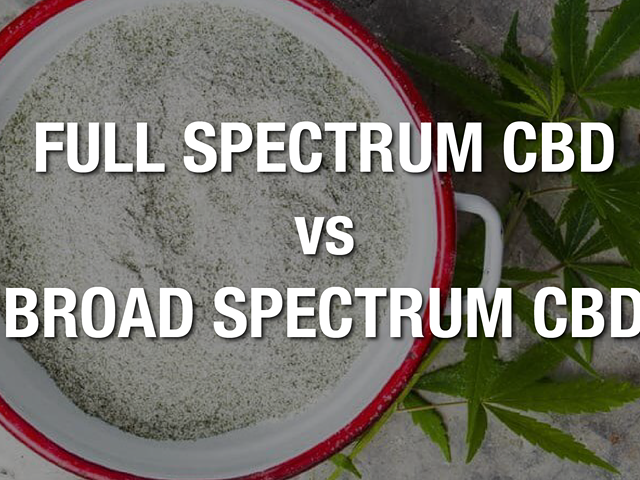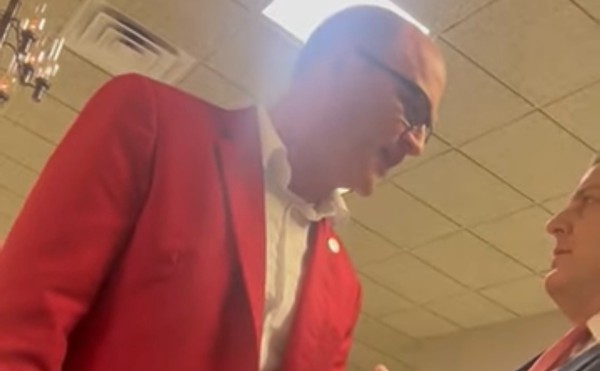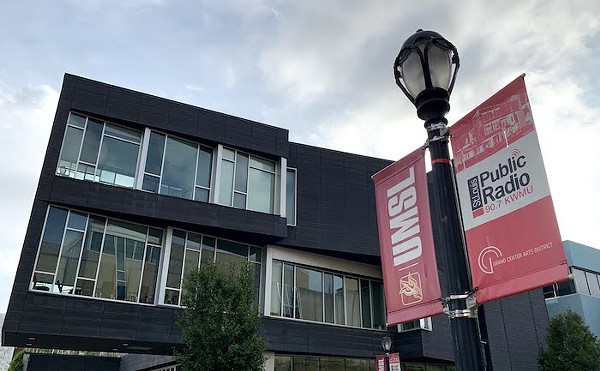As George Floyd lay dying, he called out for Larcenia.
"Mama!" he shouted twice. But Mama could not help him. Larcenia Floyd has been dead for two years, but the invocation of her spirit in George Floyd's final moments was an act so widely understood, it is possibly the most heartbreaking moment of that video.
As days passed and photos surfaced from Floyd's life, one picture of George and Larcenia showed the tender relationship between mother and son. It's one of George snuggled into his mother's lap, asleep, with both Larcenia's hands wrapped around him. It is a universal image, one that provides comfort and the familiar feeling of having a parent love and protect their child.
George did not call out for a brother. He didn't call out for a friend. He called out for Mama, a Black woman who fought for him and loved him.
George Floyd is not the first Black man to be murdered by police. He is also not the first person whose killing was captured on video. In 2020 alone, the hashtags with the names of Black men killed by police have been numerous. And yet, the women — people like Breonna Taylor, Atatiana Jefferson, Nina Pop and Sandra Bland — trending in recent years on social media have not received the sort of attention that Black men received. There was no major protesting across cities in America, no burning, no intense representation of anger of the masses.
But four young women in St. Louis have not forgotten. Activists Natasha Jain-Poster, Brooke Jones, Bersabeh Mesfin and Daishanae Crittenden see these hashtags and internalize them. They see their friends, sisters, aunts and mothers lost in the Strong Black Woman and Women of Color tropes accepted by society, just as they see their fathers, boyfriends and peers in the Black men slain by police.
Back in 2014, the women were just juniors at Clayton High School and Parkway West High School, friends who'd known one another since middle school. They began seeing each other regularly after graduating, having conversations surrounding activism and the political climate. When Michael Brown was killed, Jain-Poster, Mesfin and Jones protested in Ferguson, while it would be a few more years before Crittenden would join them in their social justice efforts.
As women who identify as Black and Brown, they decided with the killing of Michael Brown, it was time to be the change they wished to see.
"The Mike Brown situation was the catalyst that got us into activism on the grassroots level and in the streets," Jain-Poster says. "But the George Floyd situation happened, and we all regrouped and decided this was something we needed to take into our own hands."
Much has been said in the news regarding protests and the activism of everyday people, but rarely have the now young adults who were in the midst of adolescence in 2014 been given the opportunity to share what it meant to see the body of someone their age lying out in the street in broad daylight.
"For me, it was very scary, because I am the oldest of five and I have four younger brothers," Crittenden says. "Just knowing that Mike Brown was a child and could've been one of my brothers — that was just scary."
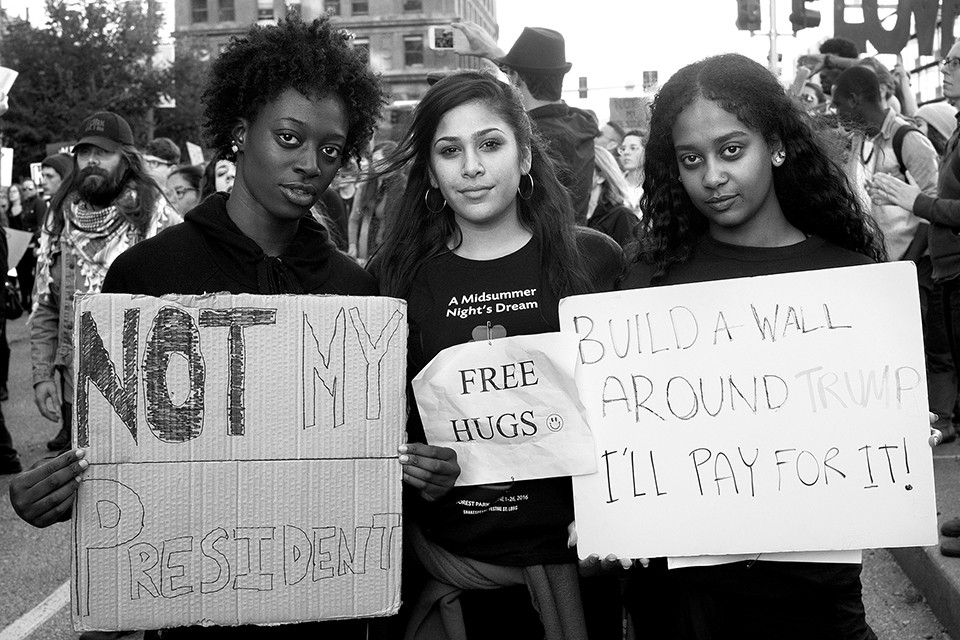
The women recall feeling deeply affected by Brown's death. Several of them knew his family personally. When the events of Ferguson made national headlines, Brown's name and image were lost in a sea of demonization, racism, cruelty and hatred. It was another reminder of what Black people and people of color have faced in the United States for decades.
The collaboration of these four women, all with varying backgrounds organizing community activism, represents the necessity of nuance in the battle for equality. Jain-Poster is a double major in international relations and Spanish; Crittenden is studying elementary education; Jones is a biology and pre-med major; Mesfin is a double major in human and social development and psychology. And while their educational pursuits provide academic insights for understanding the world and political climate around them, they recognize that those studies alone are not enough for anyone seeking equality.
The women agree that Michael Brown was the catalyst and George Floyd the reminder for their activism. In June, the women rebirthed their own movement, with Crittenden joining as the fourth member of the group. Now halfway through college at their respective universities, the women are still unsatisfied with the efforts to raise awareness and speak out against police brutality. So they've gone to work. It was in the collective experience of living during a pandemic and having the time to organize that they found the opportunity to push for more change.
"When we started to talk about the murdering of George Floyd, there hadn't been any action in St. Louis," Jones says. "That's when we said we couldn't keep waiting on somebody to do something, so we went ahead and created our own protest."
In just under a week, the women organized the largest protest in St. Louis thus far. Named the Protest Against Police Murder, its creation quickly gained traction in the community, the group says. It was their first experience organizing a protest, combining all of their diverse backgrounds and skills into the largest group project they'd ever undertaken.
They utilized social media to the fullest extent. With Jones' skills in graphic design, they were able to produce an effective flier that drew attention online. Its colors, font and photos all had a meaning and served a purpose. Facebook allowed the women to create a streamlined place where all of the group's information could effectively be disseminated. People interested in showing support could stay in the know about every update.
But organizing a protest takes more than access to the internet. The women made sure to go over their plans in detail. That included driving through downtown to scout a potential march route and reading up on laws for protesting and mass gatherings, along with having legal and defense funds set up just in case things went wrong. They thought about all communities, too. With the overwhelming support from people with resources online, the group amassed donations of water, masks, backpacks, hand sanitizer and first-aid kits. Medics were on site during the protest as well.
The group credits technology as the major boost to getting the word out about their protest, but it was the support and eagerness of the community reaching out and offering help that they are most grateful for.
"The popularity the movement has gotten has caused people to be interested in helping out at a large rate," Jain-Poster says. "People want to be led, and we were willing to lead. We had a vision, and we created an extremely organized protest, because we wanted to do things on our terms."
The first order of business was to emphasize that the Protest Against Police Murder was nonviolent. Across the group's Facebook event page, this was continuously enforced. As peaceful protests turned into riots with cities burning across the U.S. in late May, the group was concerned about their message getting lost, or individuals showing up to dilute the protest's purpose and act in self-interest rather than for the cause.
"There's people protesting in cities all over the United States every single day since George Floyd's murder, but the media doesn't show all of that," Mesfin says. "You get the most coverage when people are rioting with looting and violence. Ninety-five percent of protests are peaceful, but people don't see that."
On the day of the Protest Against Police Murder, thousands gathered downtown in front of City Hall. To say June 7 was a hot Sunday afternoon is misleading. It was scorching for a late spring day, but that means nothing in St. Louis. As protestors arrived in droves, the women stood with a nervous excitement. Their crew of over 200 volunteers was in place, some handing out water while others kept the crowd in control and in step with the march and helped recite chants. About 1,800 people had pledged on Facebook to attend, but multiples of that number soon arrived. At about 2:30 p.m., Jain-Poster, Jones, Mesfin and Crittenden began leading the crowd toward the St. Louis Metropolitan Police headquarters.
As they marched, their practiced and strategic chants echoed off vacant buildings and high-rise apartments. A sea of people snaked through the streets, clearing any sort of barricade in the way.
"Show me what democracy looks like!" the women chanted.
"This is what democracy looks like!" the crowd responded.
Marching backward, the four women could see the faces of people fighting for justice that day. The sun beaming, they brought the crowd to a halt. Jain-Poster encouraged everyone to sit down and reflect. She asked them to close their eyes, to think about what was happening in that moment and how important this day was. Their event was a protest meant to touch all corners of St. Louis. The women strove to provide a safe space for everyone focused on the matter at hand, the firm belief that all Black lives matter.
It was a peaceful protest, one in which people from all walks of life came together and showed a rare form of solidarity in a city like St. Louis. Aerial-view photographs showed people completely filling the streets and spilling across the sidewalks, from building to building, for blocks.
The day didn't start and end with marching. The protest also included speakers from diverse communities, featuring ASL interpreters for the deaf and hard of hearing, representatives from the LGBTQIA+ community, medics and local politician Cori Bush. The women didn't want their protest to be a matter of marching with signs and chants, then returning home. They provided an application for speakers on Facebook, making sure the right message would be heard.
In addition to the protest, the organizers spearheaded a list of demands. At the top of that list was reparations for the Black community, along with demilitarizing and defunding the police. The latter has become a heated topic in recent weeks, with many misinterpreting the meaning. Put simply, defunding the police means allocating funds back into the community, via health and human services, affordable housing, social work and much more.
The day of the protest proved to be an emotional one for the women, as something that started as an idea a week prior turned into an overwhelming turnout and amount of community activism.
"It was the most solidarity I have ever seen with my own eyes," Jain-Poster says.
With each murder of a Black person committed at the hands of police, the names of everyday citizens become household names. Black America understands and recognizes the collective groan of seeing a new name trending and the details that follow. It's not a surprise. But coupled with a global health crisis and sheltering at home, non-POC individuals and communities have been forced to pay attention. So much so that major companies spent two weeks denouncing racism, pledging their support of the Black Lives Matter movement and turning social media screens dark on #BlackOutTuesday. The women agree that everyone must do their part to make true and substantial change.
"There's information going around about something called 'performative allyship,'" Jain-Poster says. "People pretend to be allies by posting things on Instagram, and it's frustrating. That's great and all, but what are you doing in the community?"
The women say social media activism alone is not enough. Black Lives Matter is not a moment. They say it is a movement. And movements require constant attention, study and reflection. For a white person who has never had to come to terms with white privilege, discussing racism and bigotry, the time is now.
"People were doing things on social media because they saw it was trending," Mesfin says. "But this is not a trend, this is our lives."
For someone who has never protested, Black or white, trying to find a place in the revolution for equality and justice can be confusing and uncomfortable. The group says it's OK to be uncomfortable, but the goal should be to constantly work to improve the lives of others, wherever that may be. Lawyers have offered services pro bono. Some people have passed out water and milk at protests. And many have donated money, collected supplies and provided necessary support over the last month.
It's become far too easy to give in to cancel culture these days. A person could tweet the wrong opinion and be jobless by the next day. On the flip side, the sort of public shaming for not having anything to say in regard to George Floyd's death and the BLM movement has become just as critical of a piece of dismantling systemic racism as physically taking to the streets to protest.
Often, rhetoric gets thrown around in the academic space about accessibility, education, "doing the work" and "organizing efforts." While those buzzwords and phrases are important, the women emphasize how anyone, regardless of educational background, is useful in demanding justice and equality. They note that while they organized the protest and galvanized the city to spring into action last month, they never set out for notoriety. Still, these four women planned, organized and executed the June 7 protest. This is important, especially as several people attempted to take credit in published news articles and photographs about the effort. It's an example of the type of erasure of Black and Brown women that is prevalent.
"We dealt with that a lot," Jones says. "It was a constant fight with a variety of men trying to take the lead or organize when we are the organizers. We really combated that by putting our foot down and being stern. When the protest happened, we weren't ready to disclose who we were, but some of the men helping us were. We saw a variety of articles giving them the credit for what we worked eight days, night and day, to do. It was insulting, because at the end of the day, they know they aren't the organizers."
The American public is familiar with the power players in the fight for Black liberation in the U.S. The same recognizable male names have been prominent in the resistance for years. But these lives overlap with women in the movement too: Angela Davis, Bree Newsome, Johnetta Elzie, Brittany Packnett, Marsha P. Johnson and many more.
Jain-Poster, Jones, Mesfin and Crittenden believe that while Black lives matter, they won't matter until all Black lives matter; that includes people who are disabled, transgender, queer and so on.
"I feel like the Black Lives Matter movement within itself is a bit misogynistic," Jones says, "and that's why, as we led chants and spoke, I made it a point to say the names of women and trans women who are suffering from the same things but do not receive the social media attention or recognition just because they are women. Yes, Black men are experiencing these problems, but so are Black women. If we're gonna talk about Black lives, let's talk about all Black lives."
Looking back on their June 7 protest, these four activists are pleased with the outcome — motivating fellow St. Louisans to be part of something purposeful and historic. On Facebook, people were energetic and have asked the group to continue organizing peaceful protests. And so they have. Their next protest is scheduled for July 12. The women say that organizing the Protest Against Police Murder at a critical time in the U.S. showed them true humanity.
"St. Louis is an extremely divided, segregated city, but on June 7th, we were one," Mesfin says.
The way she, Jain-Poster, Jones and Crittenden see it, an entire movement was born out of the desire to get people to just do something positive.
And so the people marched. They wore masks and handed out water. They moved cement blocks for people who are disabled and mothers with strollers. They took to the streets in the summer humidity during a pandemic. Some offered free legal services. Others collected money for bail funds, first aid and small business reconstruction. The people didn't retreat in fear or join an online book club to quell their feelings of guilt and fragility. They wrote letters and stood on the steps of City Hall with fists raised in the air, exercising their right to live, walk home, sleep, drive, buy groceries, wear a hoodie, jog, play video games, listen to music and breathe.
This is what community looks like.

